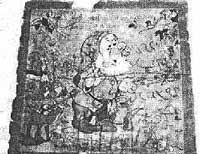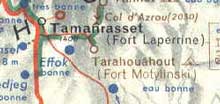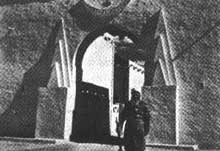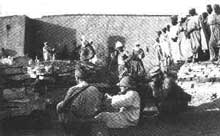Index
Index
The153 Club
The Agades Cross
People of the Sahara
Saharan Landscapes
Saharan Salt Trade
The Gundi
Illizi Festival 2000
Sahara Freeze-up
Camel Cheese
153 News Update
Join the 153 Club
Père de Foucauld
L'Arbre du Ténéré
1
L'Arbre du Ténéré 2
Saharan Forts 1
Saharan Forts 2
Saharan Rock Art
Giraffe Engravings
Leo Africanus
Battuta's Saharan travels
Shabeni's Timbuktu
Timbuctoo the Mysterious
Heroditus & Pliny on Libya
Timbuktu, a poem
Joliba Trust
Ibn Khaldûn quotes 1
Ibn Khaldûn quotes 2
Ibn Khaldûn quotes 3
Ibn Khaldûn quotes 4
Ibn Khaldûn quotes 5
Ibn Khaldûn quotes 6
Old Michelin Maps
Early NW Africa Map 1
Early NW Africa Map 2
Early NW Africa Map 3
Early NW Africa Map 4
Early NW Africa Map 5
Saharan Exploration
Henry Barth 1
Henry Barth 2
Henry Barth 3
Denham & Clapperton 1
Denham & Clapperton 2
Haardt & Audouin-Dubreuil 1
Haardt & Audouin-Dubreuil 2
Haardt & Audouin-Dubreuil 3
Haardt & Audouin-Dubreuil 4
External Links
Jim
Mann Taylor's Home Page
___________________________
____________
Index
Index
The153 Club
The Agades Cross
People of the Sahara
Saharan Landscapes
Books on the Sahara(1)
Books on the Sahara(2)
Books on African Art
Saharan Salt Trade
The Gundi
Illizi Festival 2000
Sahara Freeze-up
Camel Cheese
153 Club Newsletter
153 News Update
Join the 153 Club
Today's African News
Père de Foucauld
L'Arbre du Ténéré
1
L'Arbre du Ténéré 2
Saharan Forts 1
Saharan Forts 2
Saharan Rock Art
Giraffe Engravings
Leo Africanus
Battuta's Saharan travels
Shabeni's Timbuktu
Timbuctoo the Mysterious
Heroditus & Pliny on Libya
Timbuktu, a poem
Joliba Trust
Ibn Khaldûn quotes 1
Ibn Khaldûn quotes 2
Ibn Khaldûn quotes 3
Ibn Khaldûn quotes 4
Ibn Khaldûn quotes 5
Ibn Khaldûn quotes 6
Old Michelin Maps
Early NW Africa Map 1
Early NW Africa Map 2
Early NW Africa Map 3
Early NW Africa Map 4
Early NW Africa Map 5
Saharan Exploration
Henry Barth 1
Henry Barth 2
Henry Barth 3
Denham & Clapperton 1
Denham & Clapperton 2
Haardt & Audouin-Dubreuil 1
Haardt & Audouin-Dubreuil 2
Haardt & Audouin-Dubreuil 3
Haardt & Audouin-Dubreuil 4
External Links
Jim
Mann Taylor's Home Page
___________________________
Index
Index
The153 Club
The Agades Cross
People of the Sahara
Saharan Landscapes
Books on the Sahara(1)
Books on the Sahara(2)
Books on African Art
Saharan Salt Trade
The Gundi
Illizi Festival 2000
Sahara Freeze-up
Camel Cheese
153 Club Newsletter
153 News Update
Join the 153 Club
Today's African News
Père de Foucauld
L'Arbre du Ténéré
1
L'Arbre du Ténéré 2
Saharan Forts 1
Saharan Forts 2
Saharan Rock Art
Giraffe Engravings
Leo Africanus
Battuta's Saharan travels
Shabeni's Timbuktu
Timbuctoo the Mysterious
Heroditus & Pliny on Libya
Timbuktu, a poem
Joliba Trust
Ibn Khaldûn quotes 1
Ibn Khaldûn quotes 2
Ibn Khaldûn quotes 3
Ibn Khaldûn quotes 4
Ibn Khaldûn quotes 5
Ibn Khaldûn quotes 6
Old Michelin Maps
Early NW Africa Map 1
Early NW Africa Map 2
Early NW Africa Map 3
Early NW Africa Map 4
Early NW Africa Map 5
Saharan Exploration
Henry Barth 1
Henry Barth 2
Henry Barth 3
Denham & Clapperton 1
Denham & Clapperton 2
Haardt & Audouin-Dubreuil 1
Haardt & Audouin-Dubreuil 2
Haardt & Audouin-Dubreuil 3
Haardt & Audouin-Dubreuil 4
External Links
Jim
Mann Taylor's Home Page
___________________________
Fort
Charlet
(south of present
day Djanet) was built on the site of the Senussi zawiya on the orders of
Captain Edouard Charlet, the commander of the French detachment which entered
the village of El Mihan, one of four which made up the oasis of Djanet.
Construction was started on 26 November 1911 and the building was occupied
from 3 December 1911. (Today the name Djanet denotes the township established
to the north of the fort.
The name Fort Charlet was not used until the position was retaken in May
1916 by battalion chief Meynier, following its capture in March 1916. Captain
Charlet had been killed in September 1915 during the 1914-1918 War. From
1910 to 1913 he had been the commander of the Saharan Company of Tidikelt
(ln Salah).
Note that the name 'Fort Charlotte' as used in a well known English book
on the Tuareg is a figment of the authors' imagination.
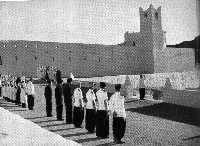
The name Miribel refers to General Miribel of the Algerian troops, who planned the conquest of Touat. 'Fort Mirabelle' as in the above book, is yet another figment of the authors' imagination.

153 travellers of the 60s and 70s will of course know Fort Gardel for its wall paintings (plus graffiti) of Snow White and the seven Dwarfs—see Happy and Sneezy to the left.

